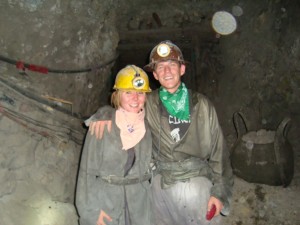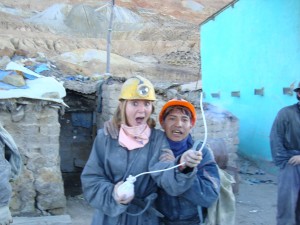Potosi was pretty unremarkable in that it is just a milder, quainter version of La Paz. We arrived at 6am after a freezing cold night journey and checked into the only hostel we could find with hot showers and central heating, the Koala Den. Over breakfast someone remarked that we should do a tour of the nearby Potosi mines. The road block to Uyuni was still in place, we had little else to do, and besides it only cost a tenner; so we booked ourselves on for that afternoon.
It turned out to be one of the most terrifying and rewarding things we’ve done on this trip. The day started out placidly – we were taken to a warehouse where we were kitted out in miner’s gear (overalls, boots and a helmet with head-torch), then to a miner’s market where we were encouraged (forced) to buy ‘gifts’ for the miners of coca leaves, dynamite and bottles of a 96% alcohol drink that they’re particularly fond of. Next we were taken to a plant which extracts ore from the raw material. Bolivia does not have the facilities to further refine the silver, lead and zinc that is mined so it is – predictably – exported to richer countries…
And then we arrived at the mines; a warren of tunnels carved into a pyramidal 5000m-high mountain which has been mined for over 400 years, contributed heavily to the coffers of the infamous Spanish conquistadores, and has claimed the lives of over 8 million people – mainly African and Indian slaves.
We entered the pitch black, dusty tunnels and within minutes – I, at least, having forgotten that I’m a bit claustrophobic – were breathing nervous staccato breaths (although the altitude may have contributed to this!). The tunnel we were walking along eventually narrowed so we could only crawl through it and our guide stopped us next to a statue of Tio – the Quechuan god/devil of the mines – and said “OK, now we descend.” He prodded his finger downwards, “like miners.” We then proceeded to dive down into the depths of the mountain, wriggling through gaps that were not even wide enough to crawl through. Every so often the rock would open up into a mine shaft where we could catch our breath before descending further.
Eventually, in 45 degree heat, we made it to the fourth – and deepest – subterranean level where we were introduced to Don Roberto and Don Martin, who had worked in the Potosi mines since childhood. They described to us (through our Quechuan guide) the appalling conditions in which they have to work, not that we needed much convincing. They work from between 12 and 24 hours a day, 6 days a week with nothing to eat except the coca leaves that they perennially chew, and they are pretty much guaranteed to contract a nasty lung disease and die before the age of 50. In the lights from our miner’s hats we could make out their big black pupils set in cadaverous faces, their cheeks bulging with coca leaves, and their soot black, torn clothes. It was a humbling experience.
We proffered our gifts, which they gratefully accepted. Don Martin scrabbled around in the rubble and brandished an empty coca-cola bottle in which he concocted a mixture of the 96% alcohol and a kind of Bolivian Irn-Bru. So there we were, drinking booze with Bolivian miners, some 50 metres underground in a cave we could barely sit up in whilst – and I kid you not – dynamite was exploding around us in the mines so that dislodged pebbles trickled down the back of our necks. Terrifying! Worst of all, we had to clamber back up the almost vertical holes we’d just come down. The relief we felt when we saw the glimmer of daylight at the end of the tunnel was almost palpable!
The next day the road block to Uyuni was lifted and we made our merry way there.


